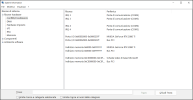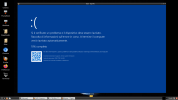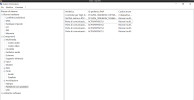Hello.
What I would like to understand is why,when I try to pass my RTX 2080 ti from FreeBSD to Windows 11,it won't do it,causing the error 12. It says that it generates a resource conflict and requires additional installation).
I'm trying to debug the error. Below you see the IOMMU group of my Nvidia Geforce RTX 2080 ti passed in a Windows 11 / bhyve VM and of Windows 11 installed physically. I'm not able to understand if there are inconsistencies.
Now,inside it I still see the error 12 :
The device PCI\VEN_10DE&DEV_1E04&SUBSYS_250319DA&REV_A1\3&61aaa01&0&48 generates a resource conflict and requires additional installation.
I have more than one GPU. I have 3 gpus.
The ones you see below :
What I'm doing is to choose (from the BIOS) this gpu and I assign it to the host :
00:02.0 Display controller: Intel Corporation CoffeeLake-S GT2 [UHD Graphics 630] (rev 02)
at the same time,I reserve the RTX 2080 ti to a guest os (Linux or Windows),by declaring this parameter inside the file /boot/loader.conf :
pptdevs="2/0/0 2/0/1 2/0/2 2/0/3"
Take in consideration that it works inside the Linux vm,but NOT in the Windows vm,because there are some kinds of conflicts between resources that I need to understand.
I ran msinfo32 and then I checked the resource sharing and conflicts tab to see which devices are conflicting with each other and I found something really interesting :


I'm not a developer,but I suspect that a patch is needed for bhyve. Windows needs that ACPI is enabled in bhyve,because I have disabled it between the bhyve parameters and this is what happened :

I tried to disable it in Windows,but every time Windows restarts,it is restored. What's the method to disable it permanently ?
What I would like to understand is why,when I try to pass my RTX 2080 ti from FreeBSD to Windows 11,it won't do it,causing the error 12. It says that it generates a resource conflict and requires additional installation).
I'm trying to debug the error. Below you see the IOMMU group of my Nvidia Geforce RTX 2080 ti passed in a Windows 11 / bhyve VM and of Windows 11 installed physically. I'm not able to understand if there are inconsistencies.
Now,inside it I still see the error 12 :
The device PCI\VEN_10DE&DEV_1E04&SUBSYS_250319DA&REV_A1\3&61aaa01&0&48 generates a resource conflict and requires additional installation.
I have more than one GPU. I have 3 gpus.
The ones you see below :
Code:
root@marietto-133:/usr/ports/www/chromium # lspci
00:00.0 Host bridge: Intel Corporation 8th/9th Gen Core 8-core Desktop Processor Host Bridge/DRAM Registers [Coffee Lake S] (rev 0d)
00:01.0 PCI bridge: Intel Corporation 6th-10th Gen Core Processor PCIe Controller (x16) (rev 0d)
00:01.1 PCI bridge: Intel Corporation Xeon E3-1200 v5/E3-1500 v5/6th Gen Core Processor PCIe Controller (x8) (rev 0d)
00:02.0 Display controller: Intel Corporation CoffeeLake-S GT2 [UHD Graphics 630] (rev 02)
00:12.0 Signal processing controller: Intel Corporation Cannon Lake PCH Thermal Controller (rev 10)
00:14.0 USB controller: Intel Corporation Cannon Lake PCH USB 3.1 xHCI Host Controller (rev 10)
00:14.2 RAM memory: Intel Corporation Cannon Lake PCH Shared SRAM (rev 10)
00:16.0 Communication controller: Intel Corporation Cannon Lake PCH HECI Controller (rev 10)
00:17.0 SATA controller: Intel Corporation Cannon Lake PCH SATA AHCI Controller (rev 10)
00:1b.0 PCI bridge: Intel Corporation Cannon Lake PCH PCI Express Root Port #17 (rev f0)
00:1c.0 PCI bridge: Intel Corporation Cannon Lake PCH PCI Express Root Port #1 (rev f0)
00:1d.0 PCI bridge: Intel Corporation Cannon Lake PCH PCI Express Root Port #9 (rev f0)
00:1f.0 ISA bridge: Intel Corporation Z390 Chipset LPC/eSPI Controller (rev 10)
00:1f.3 Audio device: Intel Corporation Cannon Lake PCH cAVS (rev 10)
00:1f.4 SMBus: Intel Corporation Cannon Lake PCH SMBus Controller (rev 10)
00:1f.5 Serial bus controller: Intel Corporation Cannon Lake PCH SPI Controller (rev 10)
00:1f.6 Ethernet controller: Intel Corporation Ethernet Connection (7) I219-V (rev 10)
01:00.0 VGA compatible controller: NVIDIA Corporation GP106 [GeForce GTX 1060 3GB] (rev a1)
01:00.1 Audio device: NVIDIA Corporation GP106 High Definition Audio Controller (rev a1)
02:00.0 VGA compatible controller: NVIDIA Corporation TU102 [GeForce RTX 2080 Ti] (rev a1)
02:00.1 Audio device: NVIDIA Corporation TU102 High Definition Audio Controller (rev a1)
02:00.2 USB controller: NVIDIA Corporation TU102 USB 3.1 Host Controller (rev a1)
02:00.3 Serial bus controller: NVIDIA Corporation TU102 USB Type-C UCSI Controller (rev a1)
03:00.0 Non-Volatile memory controller: Micron/Crucial Technology P1 NVMe PCIe SSD[Frampton2] (rev 03)What I'm doing is to choose (from the BIOS) this gpu and I assign it to the host :
00:02.0 Display controller: Intel Corporation CoffeeLake-S GT2 [UHD Graphics 630] (rev 02)
at the same time,I reserve the RTX 2080 ti to a guest os (Linux or Windows),by declaring this parameter inside the file /boot/loader.conf :
pptdevs="2/0/0 2/0/1 2/0/2 2/0/3"
Take in consideration that it works inside the Linux vm,but NOT in the Windows vm,because there are some kinds of conflicts between resources that I need to understand.
I ran msinfo32 and then I checked the resource sharing and conflicts tab to see which devices are conflicting with each other and I found something really interesting :

I'm not a developer,but I suspect that a patch is needed for bhyve. Windows needs that ACPI is enabled in bhyve,because I have disabled it between the bhyve parameters and this is what happened :

I tried to disable it in Windows,but every time Windows restarts,it is restored. What's the method to disable it permanently ?


